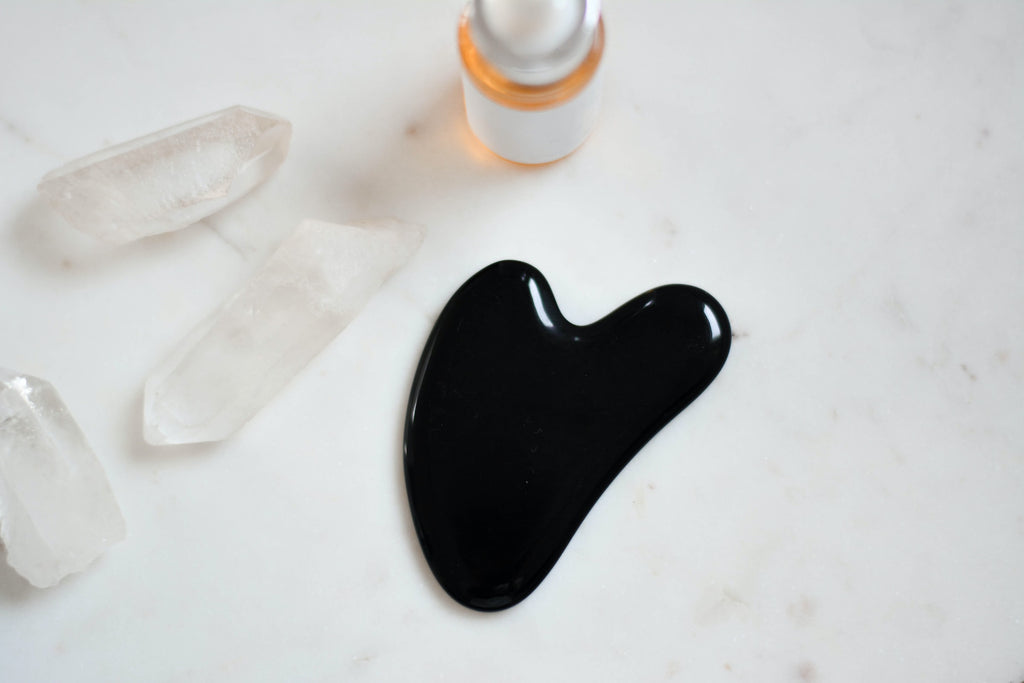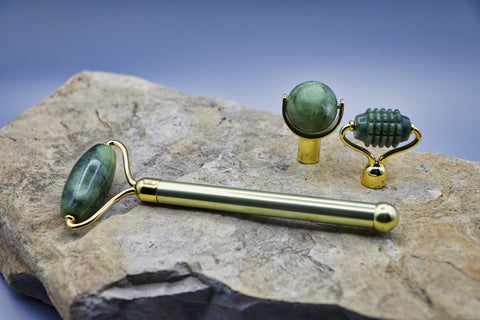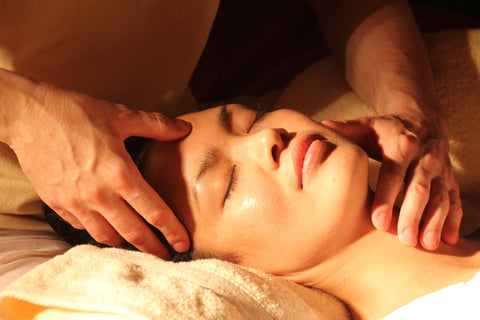If you're looking for ways to give your face a good massage without having to go to a spa, you can do so at home with the help of essential oils.
Essential oils have various benefits, but aren't as safe as other products - they should only be used with caution.
Use mild pressure for the massage, and don't worry if you don't know what to do!
Benefits of Facial Massage
Facial massage can help relieve jaw pain and headaches. The easiest muscles to massage are the masseter muscle and the temporalis muscle.
The masseter muscle covers the back part of the cheeks, the temples, and a large part of the side of the skull.
You can feel this muscle bunching up underneath your fingertips if you clench your jaw. The benefits of facial massage are similar to those of body massages. The most common face massage technique is gentle stroking and tapping. The goals of facial massages are similar to those of a body massage: to reduce muscle tension and promote facial skin health. In general, a facial massage should last three to five minutes and should be done three times a week. It is important to remember to always use mild pressure when massaging your face to avoid overstimulation.

Facial massage can reduce puffiness, improve circulation, reduce stress, and relieve stiff muscles. The increased blood flow in your face can help your skin absorb moisturizers and serum more easily. It can also help your skin tone. And lastly, a facial massage can increase your skin's elasticity. That means it's an excellent choice for aging skin. So, how can you give yourself a facial massage? Find out by following these easy steps!
Techniques
Before you begin, there are a few things you should do to prepare your face for a massage. The first step in preparing your face for massage is to wash it thoroughly and dry it thoroughly. This is to ensure that your face is completely free of any makeup or other debris, so you can move smoothly. Next, wash your hands thoroughly with lukewarm water, patting them dry, and then apply a mild cleanser to your face.
One of the benefits of facial massage is that it helps your skin absorb skincare products better. This happens because it creates heat as you massage your face. The warm feeling you experience during a massage increases the efficiency and effectiveness of key ingredients in your skincare products. They can then reach deeper layers of skin to target specific skin conditions or concerns. As long as you use a good oil or serum, you can massage your face at home.
To begin your facial massage, use your fingertips to gently press the skin in circular motions. Then, place your fingertips just above your eyebrows and gently massage the area around them. Next, take your fingertips and rub them over your chin, jaw, and cheeks. Repeat this movement several times, focusing on each area in the center of your face. If you're new to face massage, use your fingertips to massage the sides of your chin, jaw, and cheeks.
The second step of facial massage is to use facial oil or cream. The one you choose will depend on the type of skin you have, and your preferences. There are many kinds of facial oil on the market, so you can find one that matches your skin type.
You can also use an anti-aging cream, which can improve the health of your skin and help reduce the appearance of fine lines and other signs of aging.
Oils
If you want to learn how to massage your face at home using oils, there are a few steps that you should follow before getting started. First, you need to prepare your skin by cleansing it thoroughly. Once you have done that, you should apply carrier oil to your hands. You can use the oil as a slip, but be careful not to use too much. If you use too much oil, you might break a capillary or make an existing one worse.
You can also try applying a light layer of facial oil to your face before you begin. This helps your fingers glide smoothly across your face, which leaves your skin feeling smooth and glowing. You can choose an oil made especially for your face type, or you can blend your favorite moisturizer instead. You can also use a mixture of jojoba oil and castor oil for extra moisture.
To improve the massage experience, try using a massage tool. A jade roller or a Gua Sha tool is an excellent option. The neck needs equal attention, so extend your facial massage movements to your neck and chest. Applying anti-aging creams before your facial massage is also beneficial, as they can help improve your skin's health and delay the onset of wrinkles and fine lines. For best results, exfoliate your skin beforehand, since this will help your skin absorb oils more easily.
Another great benefit of massaging your face with oils is the benefit of increased blood circulation. It brings fresh blood, oxygen, and nutrients to your face while activating lymphatic drainage, which removes toxins and clears stagnation. And it's quick and easy! You can even do it in the shower! So, if you want to learn how to massage your face at home, take a look!
Serums
Whether you use facial oils, lotions, or serums, it is crucial to know how to properly massage your face. When you are massaging your face, you should be gentle, as oil can clog pores. Water-based products are more comfortable for oily skin and won't clog your pores. If you prefer a softer massage, use a silky serum or cream.
Apply the serum after cleansing your face. Then, apply a dime-sized amount of moisturizer to seal in all of the serum's beneficial ingredients. Once the serum is on your face, massage it around your forehead, chin, and nose. If you prefer a thicker serum, warm it first in your hands and then apply it to your face. After applying the serum, gently press your face in circular motions for 30 to 60 seconds.

Ideally, serums should be applied before moisturizer, as the latter will create a layer that prevents the product from being absorbed.
Oils and thick creams, on the other hand, will clog pores and will inhibit the absorption of the serum. Instead, mix the two products together to create a multi-tasking serum that addresses various skin concerns.
To find the right serum for your needs, you should first choose one that works well for your skin type and your desired results.
Acupressure Points
If you're looking for a great facial massage at home, try acupressure. These points are located in many areas of the body, including the head and face. Facial acupressure is a great way to tone your facial muscles, promote circulation, and balance energy flow. You can also work on the body by focusing on the large intestine 20 (LI20) acupressure points, which are located at the base of the nose. You can even use acupressure points on your hands, such as the inner and outer gate points, located at the base of your thumb.
To begin, apply a cream to your face. Next, move to the temples and massage them gently. Repeat these steps on all four acupressure points on your face. A few times a day will give you incredible results. And you can do it yourself too! Just make sure to use a quality organic facial oil or a good oil-based facial serum.
You can also try acupressure on your hands to relieve acne and reduce lines around the eyes. It can also help you deal with allergies, sinus inflammation, and lower back pain. Lastly, acupressure on the face can improve the look and feel of your skin. Try it out on your face at least three times a week for great results! You'll be surprised at the difference. There's no reason to wait until your face starts to wrinkle! So, get started right away!
If you're a beginner, you can try acupressure on your face for great benefits. Simply press a particular point, or a series of points, using firm yet gentle pressure, for 30 seconds. Make sure not to pull the skin, and release the pressure slowly. It will give the body tissues time to respond. When you've finished, you'll have a gorgeous complexion.

Conclusion
Facial massage can improve bone structure and help alleviate jaw pain and dysfunction. It is often part of a more comprehensive treatment plan. Health professionals specialize in the facial muscles and can give you the advice to prevent a problem from recurring. Moreover, it can be a great stress reliever, especially when used in conjunction with meditation. If you're looking for an effective way to relax and relieve stress, facial massage can help.
People Also Ask
How to massage your own face?
There are many benefits to face massage, including improved circulation and skin tone. To get the most out of your face massage, it's important to know how to do it correctly. Here are some tips:
- Use gentle, circular motions when massaging the face.
- Be careful not to pull or stretch the skin.
- Avoid using any oils or creams on the face, as this can clog pores.
- Start with the forehead and work your way down to the jawline.
- Finish with a light touch over the entire face.
What is a face massage?
A face massage is a type of massage that is specifically designed to target the muscles and tissues in the face. This type of massage can help to improve circulation, reduce stress and tension, and promote relaxation. There are a variety of different techniques that can be used during a face massage, and it is important to choose a method that is right for your individual needs.
Is gua sha good?
Gua sha is a traditional Chinese healing technique that involves scraping the skin with a smooth, blunt object. The purpose of gua sha is to improve circulation and promote healing. Gua sha is said to be beneficial for a variety of conditions, including pain, stiffness, and inflammation. To perform gua sha, the practitioner will lubricate the skin with oil and then scrape the skin with a gua sha tool. The tool is usually made of jade, horn, or bone. The practitioner will scrape the skin in a downward motion, applying pressure as needed. Gua sha should not be painful, but it may cause bruising.
ABOUT THE AUTHOR
Olivia Poglianich
Content Strategist
Olivia Poglianich is a nomadic brand strategist and copywriter in the wooden crafts and 3D product design space who has worked with brands such as Visa, Disney and Grey Goose. Her writing has taken her all over the world, from a Serbian music festival to a Malaysian art and culture event. Olivia is a graduate of Cornell University and is often writing or reading about travel, hospitality, the start-up ecosystem or career coaching. Her latest interests are at the intersection of web3 and communal living, both on and offline.






